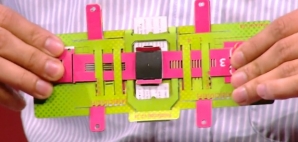Free Microscopes for Citizen Scientists
 Paper microscope developed by Stanford bioengineer
Paper microscope developed by Stanford bioengineer Photo credit: TED
Free Microscopes for Citizen Scientists
Stanford Woods Intsitute-affiliated bioengineer gives away thousands of microscope kits to foster scientific interest, encourage research on environmental public health issues
Stanford Woods Institute-affiliated bioengineer Manu Prakash is giving away 10,000 build-your-own paper microscope kits to citizen scientists with the most inspiring ideas for things to do with this new invention.
The invention, called Foldscope, is a print-and-fold optical microscope that can be assembled from a flat sheet of paper. Although it costs less than a dollar in parts, it can magnify objects over 2,000 times and is small enough to fit in a pocket.
Prakash initiated The Ten Thousand Microscopes Project, funded by the Gordon and Betty Moore Foundation, as a way to open up the wonders of the microscopic world to future generations of scientists and engineers. Through this project, Prakash and his team will assemble a crowd-sourced biology microscopy manual that includes examples of creative uses for his microscope, collected from the scientists, teachers, tinkerers, thinkers, hackers and kids who participate.
When Prakash wants to impress lab visitors with the durability of his Origami- based paper microscope, he throws it off a three-story balcony, stomps on it with his foot and dunks it into a water-filled beaker. Miraculously, it still works. Even more amazing is that this microscope — a bookmark-sized piece of layered cardstock with a micro-lens — only costs about 50 cents in materials to make.
Prakash’s dream is that this ultra-low-cost microscope will someday be distributed widely to detect dangerous blood-borne diseases like malaria, African sleeping sickness, schistosomiasis and Chagas. Prakash is the principal investigator for a related project funded by the Stanford Woods Institute's Environmental Venture Projects program.
“I wanted to make the best possible disease-detection instrument that we could almost distribute for free,” said Prakash. “What came out of this project is what we call use-and-throw microscopy.”
The Foldscope can be assembled in minutes, includes no mechanical moving parts, packs in a flat configuration, is extremely rugged and can be incinerated after use to safely dispose of infectious biological samples. With minor design modifications, it can be used for bright-field, multi-fluorescence or projection microscopy.
One of the unique design features of the microscope is the use of inexpensive spherical lenses rather than the precision-ground curved glass lenses used in traditional microscopes. These poppy-seed-sized lenses were originally mass produced in various sizes as an abrasive grit that was thrown into industrial tumblers to knock the rough edges off metal parts. In the simplest configuration of the Foldscope, one 17-cent lens is press-fit into a small hole in the center of the slide-mounting platform. Some of Prakash’s more sophisticated versions use multiple lenses and filters.
To use a Foldscope, a sample is mounted on a microscope slide and wedged between the paper layers of the microscope. With a thumb and forefinger grasping each end of the layered paper strip, a user holds the micro-lens close enough to one eye that eyebrows touch the paper. Focusing and locating a target object are achieved by flexing and sliding the paper platform with the thumb and fingers.
Because of the unique optical physics of a spherical lens held close to the eye, samples can be magnified up to 2,000 times. (To the right are two disease-causing microbes, Giardia lamblia and Leishmania donovani, photographed through a Foldscope.)
The Foldscope can be customized for the detection of specific organisms by adding various combinations of colored LED lights powered by a watch battery, sample stains and fluorescent filters. It can also be configured to project images on the wall of a dark room.
Prakash is passionate about mass-producing the Foldscope for educational purposes, to inspire children — our future scientists — to explore and learn from the microscopic world.
In a recent Stanford bioengineering course, Prakash used the Foldscope to teach students about the physics of microscopy. He had the entire class build their own Foldscope. Then teams wrote reports on microscopic observations or designed Foldscope accessories, such a smartphone camera attachment.
For more on Foldscope optics, a materials list and construction details, read Prakash’s technical paper. Watch Prakash discuss Foldscope as part of a TED talk.
To apply for a Foldscope kit, submit ideas on how you would use your microscope to signup@foldscope.com. Recipients must pledge to document their experiments in a way that could be replicated by anyone. Submission details and sample proposals are posted at Foldscope.com. Kits will be shipped in August 2014 to the applicants with the best ideas.
